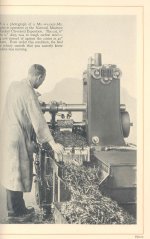Reeltor
Cast Iron
- Joined
- Jun 10, 2009
- Location
- Lawrenceville, GA USA
I’m watching the videos of K&T’s, and Cincinnati’s taking huge cuts in one pass. I know a 22L is not a monster mill like a K&T, but it does have a NMTB 50 spindle. How capable is (or should be) a Van Norman 22L in the horizontal mode? I have both A & B arbor supports and 1” & 1-1/4” arbors; I don’t have an outboard support.
Yesterday I wanted to take a .370 wide cut, total of .100 deep in A-36 hotrolled. Using a 1” arbor and “B” support, I tried a 4” HSS wheel with 16 teeth, checking some on-line calculators; I came up with vastly different recommendations. One said to use 86 rpm at 2.4 inch/minute feed, the other recommended 1,400 rpm with a feed of 270-ipm.
I tried 95 rpm and feeds of 1.6 & 2.3 ipm. I tried a number of different depths of cut, from .030 through .060, the mill made a lot of noise.
I then tried the same cut using a 1-1/4” arbor, “B” support with a 6”-24-tooth carbide wheel. At 95 rpm and 1.6-ipm I got a washboard finish, so I increased the spindle to 180 rpm. The finish improved, and mill noise was the same at both settings. In hindsight, I think I should have tried slowing the spindle down, 50-rpm is the slowest possible.
For the most part I’ve used the mill in vertical mode cutting aluminum and it’s done everything I’ve asked of it. I do have the mill sitting up on 4x4’s so I can get a pallet jack under it when needed; do I need to put the machine down on the concrete and see if it makes a difference?
I want to take advantage of its horizontal capability, what should I expect from it (1954 build date)?
Mike
Yesterday I wanted to take a .370 wide cut, total of .100 deep in A-36 hotrolled. Using a 1” arbor and “B” support, I tried a 4” HSS wheel with 16 teeth, checking some on-line calculators; I came up with vastly different recommendations. One said to use 86 rpm at 2.4 inch/minute feed, the other recommended 1,400 rpm with a feed of 270-ipm.
I tried 95 rpm and feeds of 1.6 & 2.3 ipm. I tried a number of different depths of cut, from .030 through .060, the mill made a lot of noise.
I then tried the same cut using a 1-1/4” arbor, “B” support with a 6”-24-tooth carbide wheel. At 95 rpm and 1.6-ipm I got a washboard finish, so I increased the spindle to 180 rpm. The finish improved, and mill noise was the same at both settings. In hindsight, I think I should have tried slowing the spindle down, 50-rpm is the slowest possible.
For the most part I’ve used the mill in vertical mode cutting aluminum and it’s done everything I’ve asked of it. I do have the mill sitting up on 4x4’s so I can get a pallet jack under it when needed; do I need to put the machine down on the concrete and see if it makes a difference?
I want to take advantage of its horizontal capability, what should I expect from it (1954 build date)?
Mike


 ; and that was one time too many! I adjusted the gibs after my climb milling fiasco and have them a little on the tight side; I'll have to put an indicator on and test for movement like Cal suggests.
; and that was one time too many! I adjusted the gibs after my climb milling fiasco and have them a little on the tight side; I'll have to put an indicator on and test for movement like Cal suggests.

